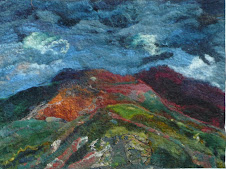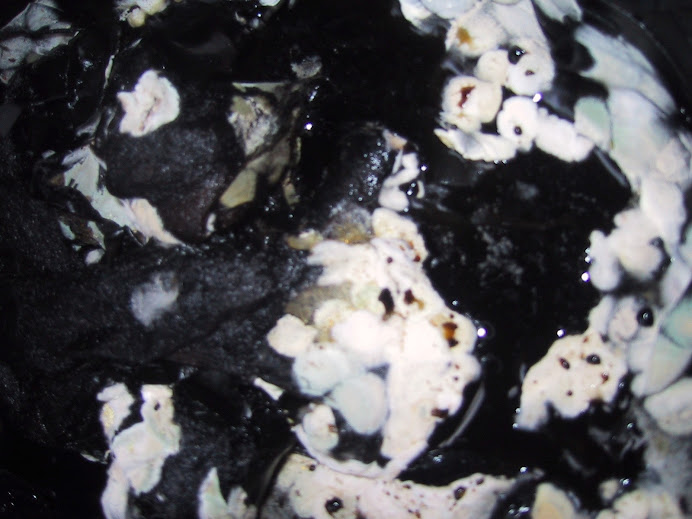This years Woolfest at the end of June in Cockermouth Cumbria was the best ever both personally for me and I gather for the Woolfest itself with 5000 visitors . On Friday they had 500 more than last year a truly impressive achievement I think. ]
 |
| The Demo area next to my stall | Photo by Peter Davies |
This was the first year I demonstrated and I had one of the new official demonstration stalls-I scheduled for 3 demos each day exhausting but worth it . FRiday was Solar Dyeing , Wild Carding and Natural Dye Inks, Saturday was Solar dyeing, Art Yarns and the Fructose and Lime vat. I was helped by Anne Campbell who taught me to spin and who stepped in and demonstrated the Art Yarns on Saturday which was a not only a huge help but actually she is better than I am anyway. ! All the Demonstrations were very popular but the one that drew the greatest interest were the Solar dyeing Demos which I did on both days and on the back of those I sold out of my new book Colours of the World Eco Dyeing and all my solar kits and I am still filling orders for these. The stall was packed and I even had people peering over the side of the stall-they must have been standing on something and I got a spontaneous round of applause. I loved it.
We finished setting up at 7.30 on the Friday having started at 3pm and after the 4 hour drive were fairly exhausted so shot down into Cockermouth and were very pleased to find the Tarantella open again -last year it was till closed after the floods and we had a lovely relaxing meal with good service . ( You can read the review
here).
The Woolfest was packed and thronged with people who did not seem to realise we were in recession. The buzz coming form being in such a dynamic and exciting event was tremendous and The standards of the stalls is amazing. I have been doing the Woolfest since the start and the standard and the range have gone up enormously . Sadly I had even less time to get round but managed to buy a fabulous spindle from IST Crafts and I have now ordered two more . I also bought some smooth fine shaped holly buttons form Tinker Tailor of the Woolclip which I dyed afterwards and I love them and will get some more. The downside was to get a cup of tea we had to walk the length of the Woolfest hall and queue and I always use the portable loos, which I think are fine- as the queue for the other is always horrendous
Enys who brings the dye plants sold out and I have been nagging her for ages to bring things like Genista Tinctoria and the walnut trees that Peter her husband lovingly nurtures. He digs up the sapling grown from nuts buried by the squirrels from a garden near a listed walnut tree with a preservation order on it and brings them on. Enys sold her Genista at Wonderwool within 15 minutes and the Walnut Tree at the Woolfest in the first hour. So now she has conceded that I have point. We are also looking at growing more native plants and she is planning for example to have the European golden rod as well as some more varieties of the Galiums .
 | Photo by Peter Davies |
| View of the stall ( and Enys) form the Demo side. |
My last demo was to have been the new Michel Garcia indigo vat with sugar and calcium hydroxide but I was surprised to find that there was very little comment from people about it and wondered if it is too new to have caught people's attention . In any event with the crowding and crushing we began to feel that despite precautions it was too dangerous to be heating water and reverted instead to demonstrating my natural dye inks again. As a result I sold a full pack of 12 inks which I was very pleased about but the customer asked me gently if I could write her instructions on how to use them particularly as fabric paints so that is my next priority.
 |
| Me showing the colours you can get from inks and wearing one of my naturally dyed felted Jacket | | | | Photo by Peter Davies |
This was the first time I had a credit card machine at the Woolfest and that took a lot of money also as much again as cash. The other thing I felt is that the people who come to the Woolfest are prepared to try things out and are looking for new and interesting things and as well as my solar kits other kits such one that using prefelt and
Debbie Bamfords naturally dyed linen threads sold well too. -and at one point we heard a cry of delight and heard someone say " oh look! Slate buttons" taking a photo on mobile and a friend arriving hot foot to get some. Our slate buttons are not any old ordinary slate buttons. They are Welsh sea washed slate carefully hand picked by Anne where they bash against the sea wall and so have rounded smooth edged and then my DH spends hours drilling holes to turn them into buttons. So they are very special buttons.
On the last night we went to the Spice Club in Cockermouth where we had the most appalling service . This came close to ruining what had been a fantastic event and is without doubt the worst experience I have ever had in a restaurant and we eat out a lot! You can read my review
here.
After the Woolfest we relaxed at a wonderful spot at Scales Farm High Lorton surrounded by the fells and Anne, who stayed with us, and I had a wonderful time spinning and dyeing with local plants while DH walked the dog off its paws.
 |
| This is what Anne and I between had in our stash to dye with . | The Kilner jars came from a kitchen shop in Cockermouth |
 |
| Setting up solar pots with local dye plants such as meadowsweet, staghorn sumach, Birch , hawthorn and some Persian berries Anne had bought at the Woolfest.In the background are some lovely rusty objects picked up from the farm with the farmers permission. ( He had trouble keeping a straight face when we asked him if we could scavenge!) |
|
 |
In the foreground of the picture above you can see some spindle spun yarn dyed with indigo. I had the stock solution for the MIchael Garcia Fructose vat in the back of the car. I warmed it up by standing it in in bucket of hot water stirred and there it was. Fully active. I started a vat off and it dyed all day and was still active the following morning without anything being added. It dyed muslin , and then wool a d silk fabric to a lovely deep blue when cold
| |
|
|


















































































